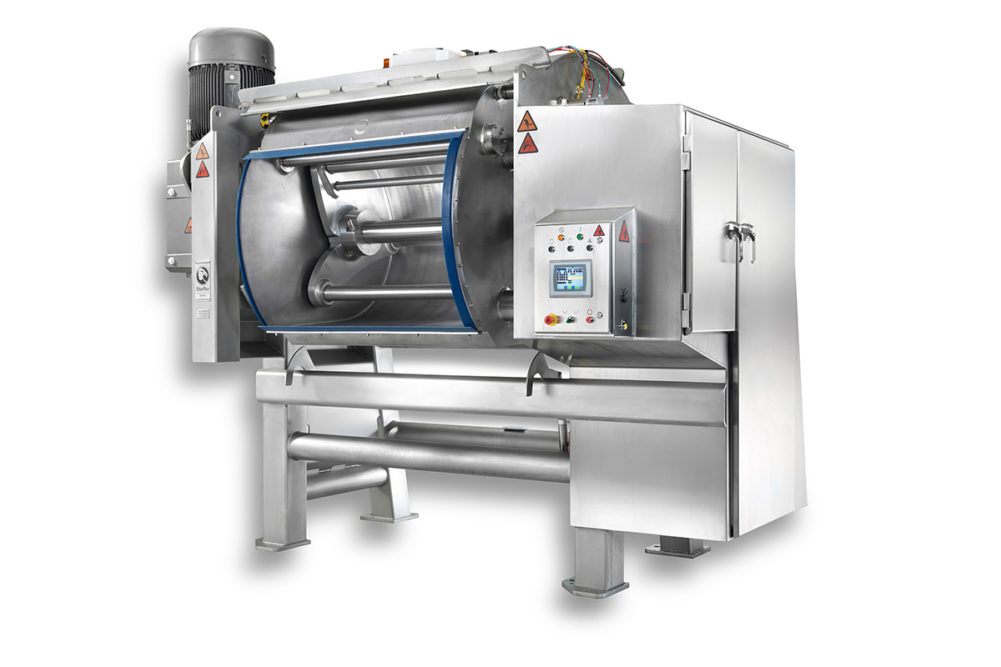Keeping equipment clean ensures that the dough is not contaminated and the mixer will last.
“Keeping the mixer clean in general is key to ensure optimal functionality,” said Peter Frederiksen, sales director, Varimixer. “Dirt and humidity can cause many potential problems with rust and bacteria. Make sure to get a stainless steel waterproof mixer, which can be cleaned with a water hose, making this process much safer and quicker. A stainless steel mixer will also last much longer and have lower maintenance costs.”
However, all that water and, in some cases, chemicals can impact the integrity of the equipment, so it is critical that mixers are designed for easy cleaning that lets water run off and withstand those caustic chemicals.
Stainless steel is at the top of the list for mixers that can stand up against cleaning chemicals.
“To improve hygiene and ease the cleaning of equipment, the choice of materials is essential,” said Claire Auffrédou, marketing and digital development, VMI. “Stainless steel is a good option for food contact and is very resistant, especially to corrosion.”
Damian Morabito, president, Topos Mondial Corp., however, pointed out that it’s important to get the correct grade of stainless steel. While a mild steel may work for some applications, it can wear more and be prone to rust.
[Related reading: Less horsepower to mix results in less strain]
Many of the recent changes in sanitary design have been minor ones with big impacts, as Andrew McGhie, director of sales, Shaffer, a Bundy Baking solution, pointed out. Round tube frame design eliminates dust buildup. Improved bowl seals prevent flour dust from escaping, and easily removable agitator shaft seals make these seals easier to clean and therefore they will be cleaned more often.
“More overt sanitary improvements include high-pressure clean in place systems that can more quickly and more thoroughly clean the agitator and bowl using less water,” Mr. McGhie said. “Simple improvements like using a removeable butterfly valve on the top of the mixer canopy stops the mixing process from back-splashing into the ingredient feed lines.”
Smooth surfaces without edges prevent dough from accumulating. Improving access is another key feature in equipment design that makes sanitation and maintenance both easier. AMF Bakery Systems’ Open Frame Mixer, for example, has a round tubular open frame that prevents flour and water from collecting. The main shaft seals are easy to remove for easy sanitation.
“All of our continuous mixers are designed with sanitation and food safety in mind,” said Matt Risser, Exact Mixing product line manager, Reading Bakery Systems (RBS). “The mixers have minimal feet to the floor, round or sloped surfaces where possible, a polished internal chamber, use of air seals over mechanical seals where possible, and mixing chambers that open in a clamshell fashion for easier access.”
RBS’s mixers also have gearmotors with maximum sanitation coatings, minimal ingredient ports and their electrical components are IP69 rated for washdown environments.
Clean-in-place (CIP) systems also automate the sanitation process and make it more efficient.
“We also develop CIP systems to offer more efficient cleaning solutions, especially on intensive production equipment such as automated mixing systems,” Ms. Auffrédou said.
E.T. Oakes’ dual-purpose sanitary pumps that meter product to the mixers and can be used as part of the CIP system as well.
“This has simplified the CIP process with less piping requirements, reduced footprint dimensions and less overall cost and complexity,” said Bob Peck, vice president of engineering, E.T. Oakes. “We also offer additional drains in the piping system to improve drainage of product for both sanitary and CIP requirements.”
This article is an excerpt from the October 2021 issue of Baking & Snack. To read the entire feature on Mixers, click here.





